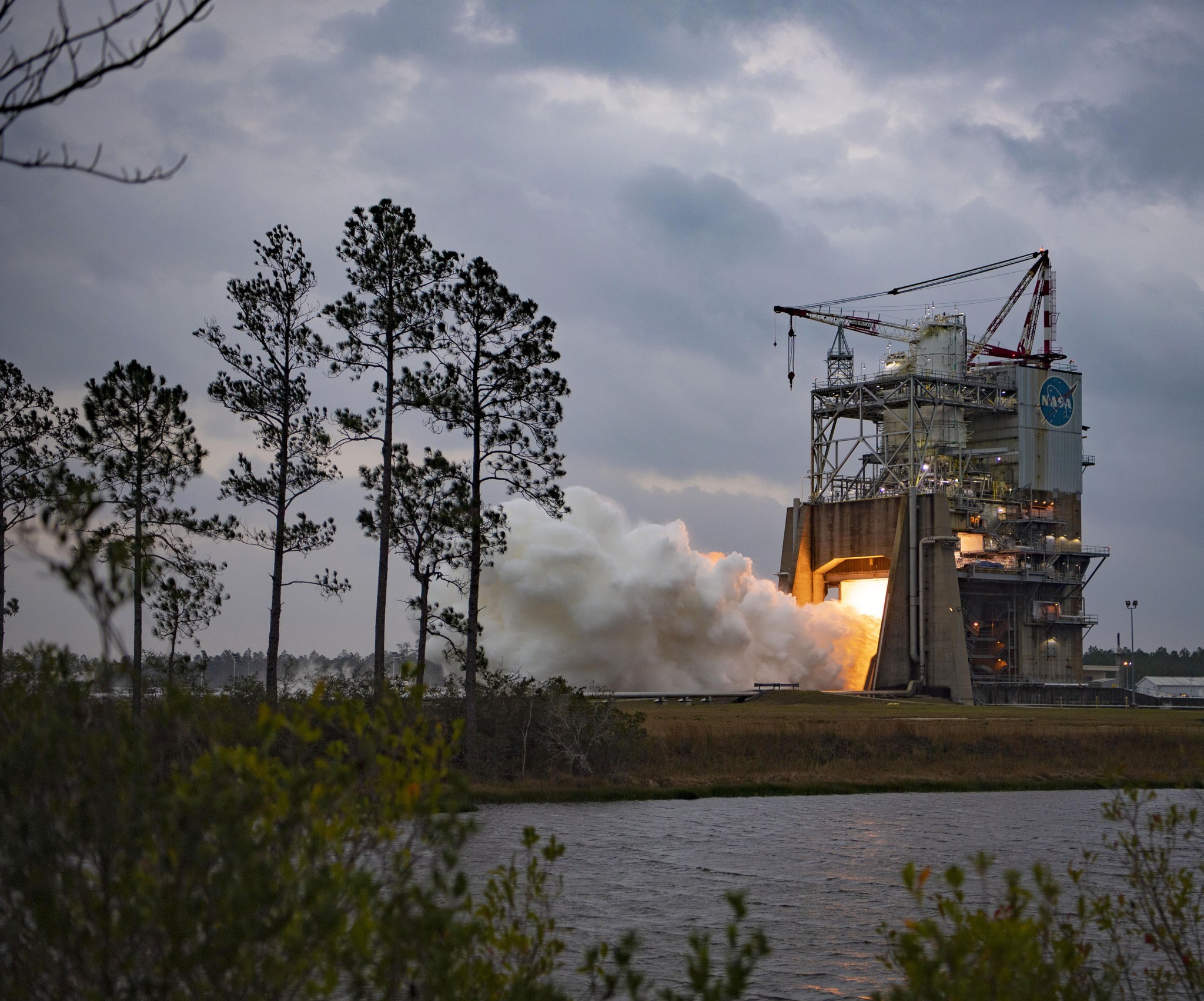Editor’s Note: This article updates NASA Conducts RS-25 Engine Hot Fire at Stennis for Future Artemis Missions, published online on Dec. 14.
NASA conducted the first test of the newly redesigned RS-25 engine for future flights of the Space Launch System (SLS) rocket Dec. 14, completing 209.5 seconds of a scheduled 500 second hot fire at the agency’s Stennis Space Center near Bay St. Louis, Mississippi.
The hot fire test was shut down early by a non-flight system used to monitor engine vibrations. Engineers use various accelerometers to monitor vibrations on engine components during a hot fire. Data review by NASA and Space Launch System lead engine contractor Aerojet Rocketdyne indicated a group of the accelerometers were improperly configured for the Dec. 14 hot fire. Test systems subsequently interpreted accelerometer signals during the hot fire as exceeding acceptable vibration limits, resulting in an early shutdown. Because engineers performed the test for redesigned engines in support of Artemis V and beyond, there were no impacts to RS-25 hardware for earlier missions.
“Much like launch, test campaigns are dynamic events that allow us to learn more about the SLS rocket hardware,” said Johnny Heflin, liquid engines manager for the Space Launch System at NASA’s Marshall Space Flight Center in Huntsville, Alabama. “NASA and Aerojet Rocketdyne teams were successful in running the first test of the new RS-25 restart engine for 209.5 seconds that will help power future missions with the SLS rocket. Preliminary data indicates the engine was performing nominally. Data analysis is underway.”
The single-engine hot fire, known as a confidence test, was designed to confirm all is ready to proceed with a series of certification tests early next year on a full RS-25 certification engine. NASA and the company modified 16 of the engines remaining after the Space Shuttle Program for use on Artemis mission I through IV. The upcoming series of testing is for the RS-25 engines that will be used beginning with Artemis V.
“Each test, even one that does not go full duration, helps us gather valuable data and helps us prepare to fly safely,” said Chip Ellis, Stennis RS-25 project manager.
The test on the Fred Haise Test Stand at Stennis came just days after NASA successfully completed the Artemis I flight test in preparation for future missions to the Moon.
The test provided initial data to aid NASA and Aerojet Rocketdyne as the company prepares to begin production of new RS-25 engines to power future Artemis missions to the Moon and beyond. For each SLS flight, four RS-25 engines, along with a pair of solid rocket boosters and core stage, help power the rocket at liftoff.
The hot fire was testing new RS-25 components to be used in production of future engines, including a new powerhead component. Additional components, including a new nozzle and controller, will be installed on the engine prior to the start of the certification series.
The hot fire marked the first test on the Fred Haise Test Stand since March when NASA completed developmental testing for Aerojet Rocketdyne efforts to modernize manufacturing processes and reduce production costs of future engines. Since that time, Stennis teams have completed critical test stand maintenance projects to support the RS-25 testing program. These included work to upgrade the stand’s high-pressure industrial water system, flame deflector, thrust vector control system, and data acquisition system.
Four RS-25 engines help power each SLS flight, firing simultaneously to generate a combined 1.6 million pounds of thrust at launch and 2 million pounds of thrust during ascent. Every RS-25 engine that will help power SLS will be tested at Stennis. RS-25 tests at the site are conducted by a combined team of NASA, Aerojet Rocketdyne and Syncom Space Services operators. Syncom Space Services is the prime contractor for Stennis facilities and operations.
Through Artemis missions, NASA will land the first woman and the first person of color on the surface of the Moon, paving the way for a long-term lunar presence and serving as a steppingstone on the way to Mars.
For information about Stennis Space Center, visit:
C. Lacy Thompson
Stennis Space Center, Bay St. Louis, Mississippi
228-342-7050
calvin.l.thompson@nasa.gov






























